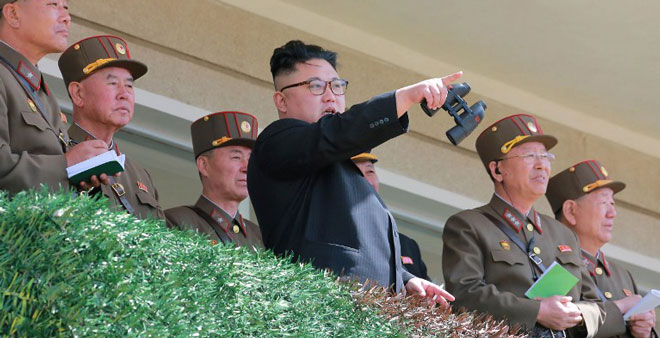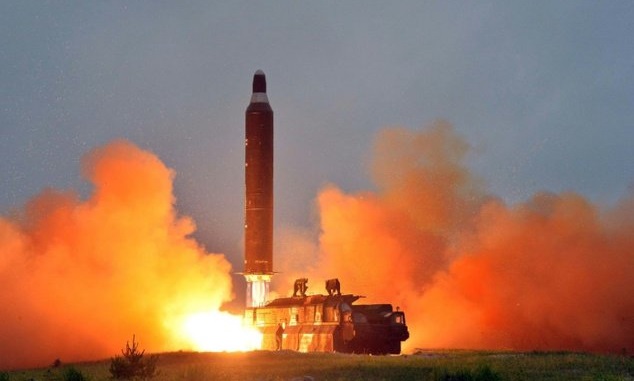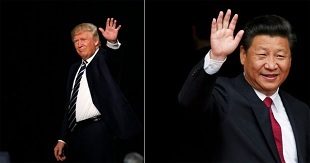
Seoul, South Korea | AFP | North Korea on Friday carried out what appeared to be its second test this month of an intercontinental ballistic missile, doubling down on its threat to develop a nuclear strike capability against the US mainland in the face of severe warnings from President Donald Trump.
South Korean, US and Japanese monitors all detected the unusual late-night test, with Japanese Prime Minister Shinzo Abe saying the missile may have landed within Japan’s maritime exclusive economic zone.
“We assess that this missile was an intercontinental ballistic missile,” Pentagon spokesman Navy Captain Jeff Davis said, adding that the projectile travelled about 1,000 kilometers (620 miles) before splashing down in the Sea of Japan.
However, the Russian military said the launch appeared to be a “medium-range” ballistic missile.
The launch came a day after North Korea celebrated what it calls “Victory Day” — the anniversary of the end of the 1950-53 Korean War. Pyongyang regularly times its missile tests to coincide with symbolic dates.
Condemnation was swift with Japan’s top government spokesman, calling Friday’s test another clear violation of UN resolutions.
“Our country will never tolerate it and made a severe protest to North Korea, condemning it in the strongest words,” Suga said.
In Seoul and Tokyo, the governments convened meetings of their national security councils.
South Korean President Moon Jae-In said Seoul would respond with a “strong military show of force,” including joint South Korea-US missile tests, according to a statement from the presidential Blue House.
– Further sanctions –
US military and South Korean intelligence officials had in recent days warned that North Korea appeared to be prepping another missile test — likely of an ICBM.
The ICBM test on July 4 had triggered global alarm, with experts saying the missile had a theoretical range to reach Alaska.
North Korean leader Kim Jong-Un, who personally oversaw that launch on America’s Independence Day, described it as a gift to the “American bastards.”
It sent tensions soaring in the region, pitting Washington, Tokyo and Seoul against China, Pyongyang’s last remaining major ally.
The United States instigated a push at the United Nations for tougher measures against Pyongyang, with US President Donald Trump saying he was considering a “pretty severe” response.
Joel Wit, a senior fellow at the US-Korea Institute at Johns Hopkins University and an expert on the North’s nuclear weapons programme, said Friday’s launch confirmed time was running out for Washington to find a way out of a pressing security crisis.
“Another North Korean test of what appears to be a missile that can reach the United States further emphasises the need for the Trump administration to focus like a laser on this increasingly dangerous situation,” Wit said on the institute’s 38 North website.
Friday’s launch came just hours after the US Senate passed bipartisan sanctions on Pyongyang, and Japan slapped its own sanctions on two Chinese firms, including a bank accused of laundering North Korean cash.

North Korea’s accelerated drive towards a credible nuclear strike capability poses a thorny policy challenge for Trump, who is at loggerheads with Beijing over how to handle Kim Jong-Un’s regime.
“It’s clear Kim Jong-Un remains undeterred by the threat of tightened sanctions, and is not listening to its one major ally, China. The longer the world waits to deal with North Korea, the more advanced Pyongyang’s arsenal will become,” said Jean Lee at the Wilson Center thinktank.
Trump has repeatedly urged Pyongyang’s chief backer Beijing to rein the Stalinist state in, but Beijing insists dialogue is the only practical way forward.
There remain doubts whether the North can miniaturise a nuclear weapon to fit a missile nose cone, or if it has mastered the technology needed for the projectile to survive re-entry into the Earth’s atmosphere.
But since Kim came to power there has been a series of technical advances, including three nuclear tests and a string of missile launches.
– ‘Frustrating’ –
Reacting to Friday’s launch, United Nations spokesman Farhad Haq said it was “frustrating” that the UN secretary general’s calls for all sides to de-escalate tensions on the Korean peninsula had gone unheeded.
In an apparent reference to China, Haq said it was important for all parties to “use their particular influence to help resolve this.”
In all, six sets of UN sanctions have been imposed on North Korea since it first tested an atomic device in 2006, but two resolutions adopted last year significantly toughened the sanctions regime.
Meanwhile, the US military is preparing to conduct another test of a missile-intercept system in Alaska, perhaps as soon as Saturday.
 The Independent Uganda: You get the Truth we Pay the Price
The Independent Uganda: You get the Truth we Pay the Price



